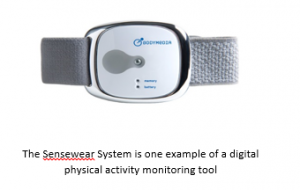 Led by Dr. Linda Li, our research team aims to understand how online physical activity monitoring tools may be used to support Canadians with arthritis in managing their disease.
Led by Dr. Linda Li, our research team aims to understand how online physical activity monitoring tools may be used to support Canadians with arthritis in managing their disease.
Being physically active can reduce pain, improve mobility and enhance quality of life. Despite these benefits, many people with arthritis are sedentary and do not have access to health professionals to learn how to stay active safely.
A range of online physical activity monitoring tools are available and have potential to improve physical activity. Examples include online diaries, pedometers, multisensor devices and global positioning system (GPS) monitors, which can be used to share detailed information about patients’ physical activity with healthcare professionals.
What remains unknown is how these tools may be used most effectively by people with arthritis to better manage their disease.
To gain in-depth insight into this topic, our research team will hold extensive focus groups and interviews with patients, health professionals and healthcare decision makers in Ontario, Alberta and British Columbia. Findings will inform the future design, testing and use of online physical activity monitoring tools to improve arthritis care.
This study is an important step forward in bringing arthritis patients’ self-management into the digital age.
Scientific posters presented about this study include:
 Arthritis Patients’ Views and Experiences of Using Digital Technologies to Improve Physical Activity Participation Presented at the American College of Rheumatology / American Health Professionals Association Annual Meeting, San Francisco, USA, November 6-11, 2015, and the Canadian Rheumatology Association Meeting, Lake Louise, Alberta, February 17-20, 2016
Arthritis Patients’ Views and Experiences of Using Digital Technologies to Improve Physical Activity Participation Presented at the American College of Rheumatology / American Health Professionals Association Annual Meeting, San Francisco, USA, November 6-11, 2015, and the Canadian Rheumatology Association Meeting, Lake Louise, Alberta, February 17-20, 2016
 Integrating Wearable Physical Activity Monitoring Tools into Rehabilitation Practice for Patients with Arthritis: the Healthcare Professional Perspective Presented at the American College of Rheumatology / American Health Professionals Association Annual Meeting, San Francisco, USA, November 6-11, 2015
Integrating Wearable Physical Activity Monitoring Tools into Rehabilitation Practice for Patients with Arthritis: the Healthcare Professional Perspective Presented at the American College of Rheumatology / American Health Professionals Association Annual Meeting, San Francisco, USA, November 6-11, 2015
Oral presentations given about this study include:
 A Qualitative Study of Arthritis Patients’ Views and Experiences of Using Physical Activity Monitoring Tools to Support Physical Activity Participation. Presented at the Arthritis Research Canada/University of San Francisco Joint Meeting, San Francisco, USA, April 14-15, 2016
A Qualitative Study of Arthritis Patients’ Views and Experiences of Using Physical Activity Monitoring Tools to Support Physical Activity Participation. Presented at the Arthritis Research Canada/University of San Francisco Joint Meeting, San Francisco, USA, April 14-15, 2016
 Web, Apps and Wearables: Tools for Joint Health? Presented at Arthritis Research Canada’s Arthritis Patient Advisory Board “Reaching Out with Arthritis Research”, November 2014
Web, Apps and Wearables: Tools for Joint Health? Presented at Arthritis Research Canada’s Arthritis Patient Advisory Board “Reaching Out with Arthritis Research”, November 2014
Scientific papers published about this study include:
![]() Using physical activity trackers in arthritis self-management: A qualitative study of patient and rehabilitation professional perspectives. Leese J, Macdonald GG, Tran BC, Wong R, Backman CL, Townsend AF, Davis AM, Jones CA, Gromala D, Avina-Zubieta JA, Hoens AM, Li LC. Arthritis Care & Research. 2019;71(2):227-236.
Using physical activity trackers in arthritis self-management: A qualitative study of patient and rehabilitation professional perspectives. Leese J, Macdonald GG, Tran BC, Wong R, Backman CL, Townsend AF, Davis AM, Jones CA, Gromala D, Avina-Zubieta JA, Hoens AM, Li LC. Arthritis Care & Research. 2019;71(2):227-236.
This study is funded by The Arthritis Society.
Principal Investigators:
Linda Li
Diane Gromala
Co-Investigators:
Aileen Davis, Toronto Western Research Institute
Allyson Jones, University of Alberta
Catherine Backman, University of British Columbia
Anne Townsend, University of British Columbia
Antonio Avina-Zubieta, University of British Columbia
Collaborators:
Gerry Sheanh, Arthritis Research Centre’s Consumer Advisory Board
Karen Tsui, Arthritis Research Centre’s Consumer Advisory Board
Cheryl Koehn, Arthritis Consumer Experts
Jennifer Burt, Arthritis Health Professions Association

I’ve used pedometer to track my activity. It stopped working last year but I have a good idea of my activity level even without it. I find walking alleviates my knee pain. I now walk 30 minutes to an hour a day, unless my knees hurt.
Hi there! I’m 27 years old and was diagnosed with JIA when I was just 2 years old. I’m leaving my feedback in regards to this subject here, as I am not legible for this study due to my geographic location .
I bought myself a Fitbit about a year ago as a motivational tool. I’ve come to find that it works great when I’m in a “good” period, as I try to beat my previous days records… It definitely gets me moving when I’m in shape. However, I’ve noticed that when I’m in a flare up, it’s not as motivating because I find myself unable to attain my daily goals. Given the unpredictable nature of JIA, I find it extremely difficult to set appropriate goals when my symptoms worsen. After experiencing, what I perceived and processed to be multiple “failures”, I chose not to wear the fitness tracker on bad days. Perhaps if I knew how to adjust my goals in a better manner I’d keep on wearing it through the flare ups.
However, I do believe that these trackers can provide doctors and health care professionals with highly valuable insight as to the disease and its impact on daily routines and physical limitations of RA patients. I think that fitness trackers and technology could be a great disease management tool, especially with the JIA clientele. Gamification can truly go a long way when it comes to motivating children (teens and adults too) to take control of their disease. For example, a simple app that rewards a patient for daily physical exercise (even if it’s those simple exercises prescribed by the physiotherapist) by leveling up or earning a badge. This alone can encourage people to move and stay fit. Or another interesting feature that could be looked into could be, including specialized metrics that measure and/or monitor (to a limited extent) disease activity. This could be helpful for both the patient and the professional in managing the disease. -And if it were deemed reliable enough, the data could be synced to the professional’s database. Also, creating an app that incorporates items such as “30 Day Challenges” (with video demonstration) that are customized and suited to a JIA or RA clientele could be motivating as well, as the challenges would be adapted to the person’s reality and limitations.
Anyways, sorry about the lengthy message… I just feel as though technology isn’t being optimized enough in the medical field when it comes to managing chronic diseases. I think that it could potentially enhance the patient-professional relationship on multiple levels if it were used wih care.